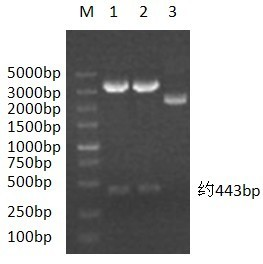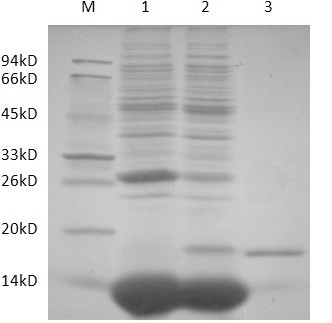gad gene of porcine globular adiponectin and protein encoded by gad gene and application
A lard, spherical technology, which is applied in the field of expression of gAd protein in recombinant Lactococcus lactis, can solve problems such as inability to satisfy consumers, and achieve the effects of improving intestinal microecological balance, reducing production costs and reducing fat deposition.
- Summary
- Abstract
- Description
- Claims
- Application Information
AI Technical Summary
Problems solved by technology
Method used
Image
Examples
Embodiment 1
[0046] Example 1 Modification of gAd gene
[0047] In this example, TAKARA Total RNA Extraction Kit was used to extract total RNA from the adipose tissue of Blue Tang pigs. Based on the adiponectin gene (gene accession number: AY135647) released by GenBank, the adiponectin Ad gene was cloned by PCR, and primers were designed. The sequence is:
[0048] Upstream primer P1: 5'GGCTCTGATTCCACACCTG3';
[0049] Downstream primer P2: 5'CTCCTAATGACACTGAAGACCTC3'.
[0050] The reaction conditions are: 94°C for 3min, 94°C for 40s, 49°C for 30s, 72°C for 40s, 30 cycles, and finally 72°C for 7min.
[0051] After the sequencing is correct, use this sequence to design primers to amplify gAd, select the gene of the globular domain of porcine adiponectin, intercept 414 bases of the globular domain, and introduce it upstream Nco I enzyme cleavage site and 6 histidines, introduced downstream Sac I restriction site. The primer design sequence is as follows:
[0052] Upstream primer P3:
...
Embodiment 2
[0059] Example 2 Construction of pNZ8048-gAd prokaryotic expression plasmid
[0060] The gAd gene was inserted into the Lactococcus lactis expression vector through restriction endonuclease and ligase.
[0061] The specific operation is:
[0062] Nco I and Sac I double-enzyme-digest the pMD18-T-gAd and pNZ8048 prokaryotic expression plasmids respectively, and recover from the gel. Ligate overnight at 16°C, then transform into the cloning host Escherichia coli by conventional chemical transformation method E. coli MC1061, chloramphenicol resistance screening, pick 10 positive colonies, and carry out PCR amplification respectively, using primers P3, P4 and the aforementioned reaction procedures and conditions. recombined plasmid Nco I. Sac I double enzyme digestion identification, refer to the appendix figure 1 , with figure 1 Among them, M represents DNA marker, 1 and 2 represent pNZ8048-gAd Nco I and Sac Ⅰ product of digestion, 3 represents the pNZ8048-gAd ...
Embodiment 3
[0064] Embodiment 3 The preparation of the recombinant microorganism containing the prokaryotic expression vector of gAd gene
[0065] Electroporate the correctly identified plasmid carrying gAd expression, the parameters are set to 2.5kV, 25aF, 400Ω, and transformed into L. Lactis NZ9000. Pick a single colony and inoculate it into GM containing chloramphenicol (5 μg / ml) 17 In liquid medium, culture overnight at 30°C. On the next day, 10 positive colonies were selected from the single colonies grown in the culture medium, and PCR amplification was performed respectively, using primers P3 and P4 and the aforementioned reaction procedures and conditions. recombined plasmid Nco I. Sac I double enzyme digestion identification, when the size of the DNA fragment obtained is consistent with that of Example 2, the recombinant Lactococcus lactis NZ9000-gAd is obtained. See the attached microscopic pictures for the strains Figure 10 .
PUM
 Login to View More
Login to View More Abstract
Description
Claims
Application Information
 Login to View More
Login to View More - R&D
- Intellectual Property
- Life Sciences
- Materials
- Tech Scout
- Unparalleled Data Quality
- Higher Quality Content
- 60% Fewer Hallucinations
Browse by: Latest US Patents, China's latest patents, Technical Efficacy Thesaurus, Application Domain, Technology Topic, Popular Technical Reports.
© 2025 PatSnap. All rights reserved.Legal|Privacy policy|Modern Slavery Act Transparency Statement|Sitemap|About US| Contact US: help@patsnap.com



